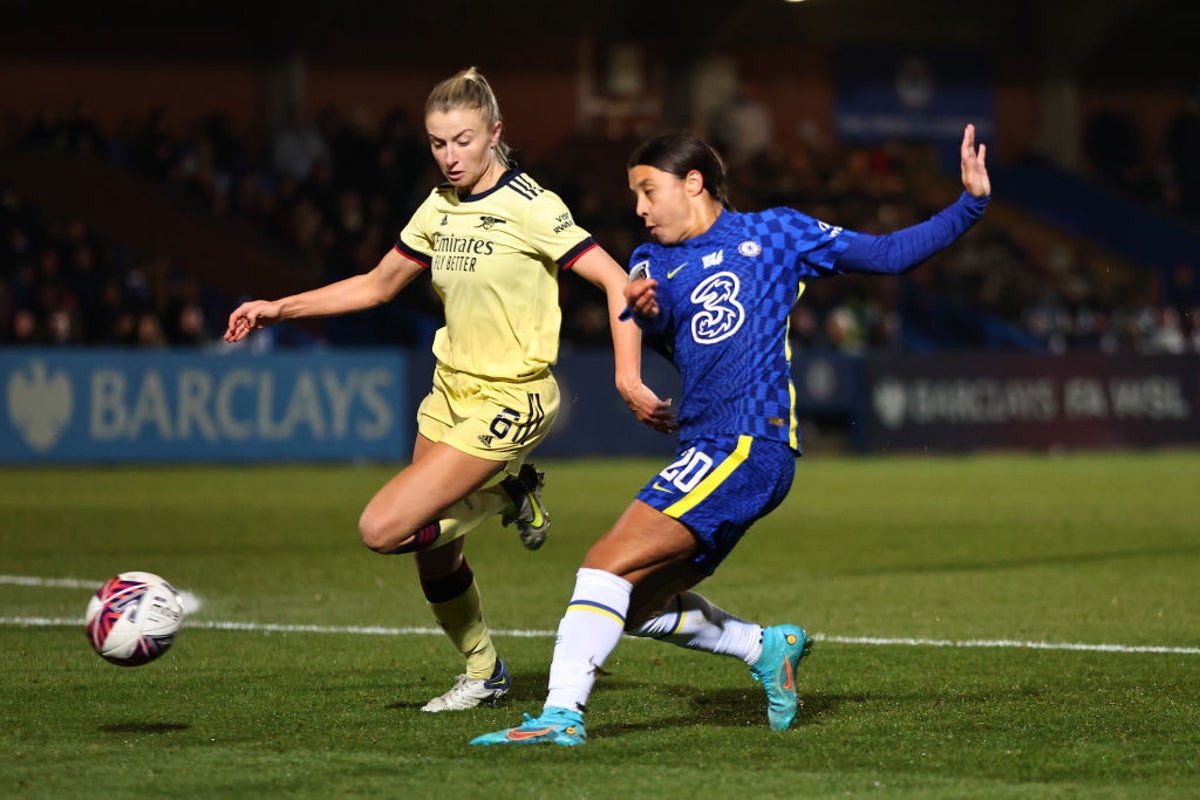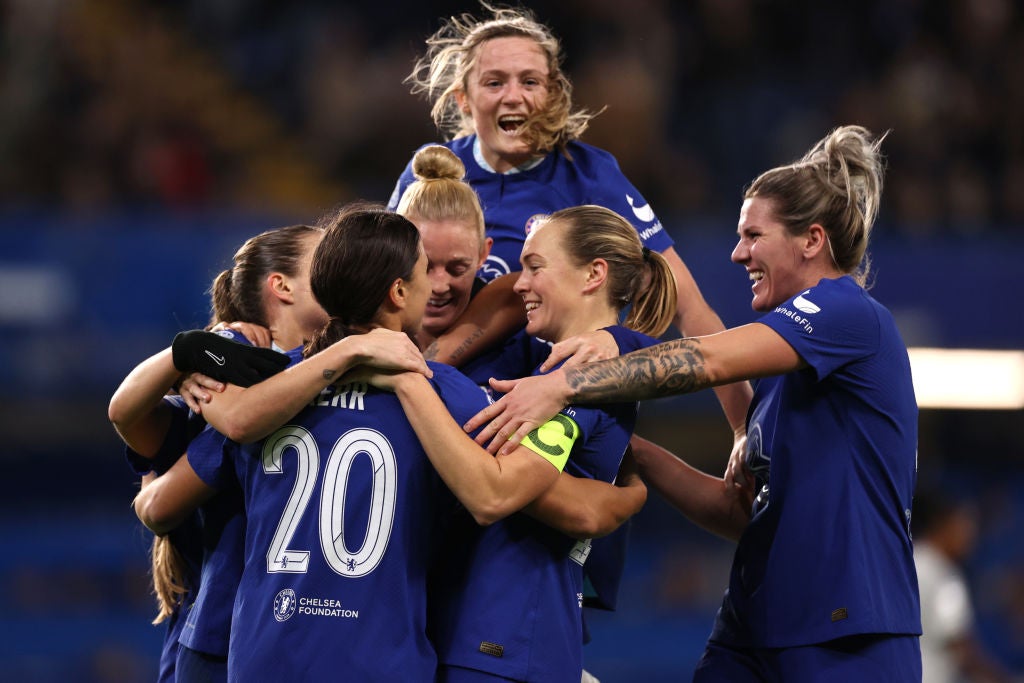
If the goal for women’s football is to constantly be aiming for bigger and better, the sight of 2023 kicking off with the most important fixture of the Women’s Super League season so far is a fitting start. In a World Cup year that will hope to build on a momentous 2022, Arsenal host Chelsea at the Emirates on Sunday in a clash that will both shape the WSL title race and set the tone for what is to follow, with another crowd of over 40,000 expected.
There is usually something on the line when these teams meet. Separated by just two points in the last season’s title race, Arsenal and Chelsea remain the two strongest sides in England, as they have shown by carrying the fight in the Champions League this campaign. Chelsea are three points ahead at the top this time around, but Arsenal have a game in hand.
Their battles in the league have been defined by fine margins, typified by last February’s goalless draw at Kingsmeadow when Arsenal were millimetres from claiming a late win. Chelsea carried their slim advantage over the Gunners to the final day of the season, where they wrapped up a third successive title. They remain the team to beat under Emma Hayes.
Arsenal and Chelsea have often represented the best of what the WSL has to offer; teams who aim to be progressive, led by managers with clear ideas of how they want their teams to play, both with talent who can make the difference at either end of the pitch. Yet, as the teams return to the Emirates and another big crowd to match the importance of the fixture, there is as much focus on who is not there than who is.
Before Christmas, Arsenal suffered the devastating double blow of losing Beth Mead and Vivianne Miedema, both to ruptured anterior cruciate ligament injuries. Mead’s injury looked innocuous, Miedema’s far more serious, but both were dealt the same news and are now serious doubts for the World Cup, set to begin in July in Australia and New Zealand.
It was a continuation of a theme that threatens to define the season. Mead and Miedema’s injuries now mean that five of the 20 players nominated for last season’s Ballon d’Or are currently sidelined with ACL issues, including Barcelona and Spain star Alexia Putellas. In the campaign that bridges the gap between last summer’s European Championships and the World Cup, the workload players face is under the spotlight more than ever.
It has triggered fresh criticism and discussion, which has extended into why there is a lack of research into why women’s footballers are so succeptble to ACL injuries. Links between anatomy and other factors such as the menstrual cycle have also been suggested, as well as the inequalties facing professional players compared to the men’s game, but clubs facing this crisis without clear recommendations on how to address it speaks to the stage they are at.

That said, there is not a quick fix, but there was anger at the timing of Fifa announcing plans for a new Women’s Club World Cup, seemingly without the consultation of teams, at a time when so many players were falling victim to injuries and amid the backlash of the existing schedule.
“I’ve said before with the playing schedule I think we have to be very smart in the way that we grow the women’s game and the calendar,” said the Arsenal manager Jonas Eidevall, following Mead and Miedema’s injuries. His thoughts were echoed by Hayes, who has lost forward Pernille Harder from her team due to a hamstring injury. “It’s killing the players,” the Chelsea manager said of the schedule.
“I’m very frustrated,” she said. “I’ve made it clear player welfare needs looking at. it’s not the fault of anybody, these injuries come for many reasons, but I feel players playing in World Cups and European Championships, being given two weeks rest between seasons, is unacceptable. We need to start putting the players first. I’m not talking on behalf of my own, it’s across the board. Look at the injuries in the women’s game.”
In the meantime, Arsenal must reconfigure if they are to challenge Chelsea over the second half of the campaign. While Miedema is still a big absence, Arsenal had to adjust earlier this season when the WSL’s record scorer took a break due to fatigue. The midfielder Frida Maanum stepped up and has been their player of the season so far, as well as their top goalscorer in all competitions. Maanum may push further forward again in order to support Stina Blackstenius, who Arsenal will be more reliant on now.
There have also been the new signings of Dutch midfielder Victoria Pelova and Danish midfieder Kathrine Kuhl, who are both considered to be top talents. It follows the exit of England international Jordan Nobbs after 12 years at the club, marking a shift in the team Eidevall is looking to build.
It is one that has been mirrored at Chelsea, as Beth England left for Tottenham Hotspur in what has been reported as a WSL record transfer. England, an unused member of England’s Euros squad, has moved ahead of the World Cup in an apparent search for game time over the second half of the season. Chelsea, already loaded with star attacking talent in Sam Kerr, Fran Kirby and Guro Reiten, have this season been bolstered by the emergence of Lauren James. After signing off 2022 with two goals in the 3-0 win over PSG at Stamford Bridge, James is set for a big year.

Chelsea will hope they are, too, starting at the Emirates. They have not dropped points since the shock opening defeat to Liverpool and could quite possibly pull themselves clear following a positive result against the Gunners. There could be a third horse in the mix this season, however, with Manchester United looking to force themselves into the conversation should they beat Liverpool on Saturday. Marc Skinner’s side recorded an excellent 3-2 win at Arsenal before the break in a full demonstration of their progress.
For now, though, it’s all about Arsenal and Chelsea, a rivalry to define the season and a highlight fixture to kick-start what should be another landmark year.







